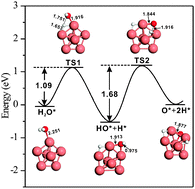A first principles study of water dissociation on small copperclusters
Abstract

* Corresponding authors
a
Institute of Theoretical Chemistry and Computational Materials Science, China University of Geosciences, Wuhan 430074, China
E-mail:
wujp@cug.edu.cn
b Department of Physics, Penn State University, Berks Campus, Reading
c Air Products and Chemicals, Inc. 7201 Hamilton Boulevard, Allentown
d
Department of Chemistry, National University of Singapore, 3 Science Drive 3, Singapore
E-mail:
chmch@nus.edu.sg

 Please wait while we load your content...
Something went wrong. Try again?
Please wait while we load your content...
Something went wrong. Try again?
L. Chen, Q. Zhang, Y. Zhang, W. Z. Li, B. Han, C. Zhou, J. Wu, R. C. Forrey, D. Garg and H. Cheng, Phys. Chem. Chem. Phys., 2010, 12, 9845 DOI: 10.1039/C001006E
To request permission to reproduce material from this article, please go to the Copyright Clearance Center request page.
If you are an author contributing to an RSC publication, you do not need to request permission provided correct acknowledgement is given.
If you are the author of this article, you do not need to request permission to reproduce figures and diagrams provided correct acknowledgement is given. If you want to reproduce the whole article in a third-party publication (excluding your thesis/dissertation for which permission is not required) please go to the Copyright Clearance Center request page.
Read more about how to correctly acknowledge RSC content.
 Fetching data from CrossRef.
Fetching data from CrossRef.
This may take some time to load.
Loading related content
